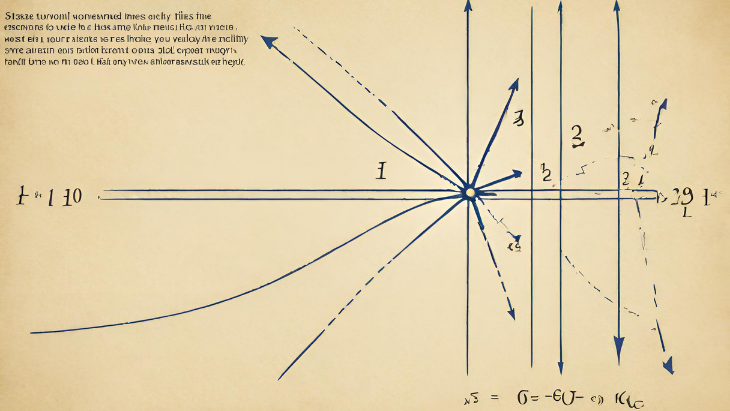Instantaneous velocity is the rate of change of the object’s position over time. It is calculated by taking the derivative of the object’s position function.In other words, instantaneous velocity is the speed and direction of an object at a specific point in time.
How to Find Instantaneous Velocity in Physics
Instantaneous velocity is the speed and direction of an object at a specific point in time. It is calculated by taking the derivative of the object’s position function.
There are two main ways to find instantaneous velocity in physics:
- Using the derivative of the object’s position function
- Using a velocity-time graph
Using the derivative of the object’s position function
The derivative of the object’s position function is the slope of the object’s position-time graph at a specific point. To find the instantaneous velocity of an object using the derivative, you would first need to find the object’s position function. Once you have the position function, you can take the derivative of the function at the desired point in time.
For example, let’s say we have an object whose position function is given by the following equation:
x(t) = t^2
The derivative of this function is:
v(t) = 2t
To find the instantaneous velocity of the object at t = 3, we would take the derivative of the position function at t = 3.
v(3) = 2 * 3 = 6
Therefore, the instantaneous velocity of the object at t = 3 is 6 m/s.
Using a velocity-time graph
A velocity-time graph is a graph of the object’s velocity over time. The slope of the velocity-time graph at a specific point is the object’s instantaneous velocity at that point.
To find the instantaneous velocity of an object using a velocity-time graph, you would first need to find the velocity-time graph for the object. Once you have the velocity-time graph, you can find the slope of the graph at the desired point in time.
For example, let’s say we have a velocity-time graph for an object as shown below:
The slope of the graph at t = 3 is approximately 6 m/s. Therefore, the instantaneous velocity of the object at t = 3 is approximately 6 m/s.
Conclusion
Instantaneous velocity is a key concept in physics. It is used to describe the motion of objects at a specific point in time. There are two main ways to find instantaneous velocity in physics: using the derivative of the object’s position function or using a velocity-time graph.
Additional details
Here are some additional details that could be included in a content piece about how to find instantaneous velocity in physics:
- A definition of derivative
- An example of how to use the derivative to find instantaneous velocity
- An example of how to use a velocity-time graph to find instantaneous velocity
- A discussion of the difference between instantaneous velocity and average velocity
- A discussion of the importance of instantaneous velocity in physics
These additional details would make the content piece more helpful for readers who are new to the concept of instantaneous velocity.
Instantaneous Velocity Formula
Instantaneous velocity is the rate of change of the object’s position over time. It is calculated by taking the derivative of the object’s position function.
The instantaneous velocity formula is:
v(t) = dx/dt
where:
- v(t) is the instantaneous velocity of the object at time t
- dx/dt is the derivative of the object’s position function
The derivative of a function is a mathematical operation that finds the slope of the line tangent to the function at a given point. In the case of instantaneous velocity, the derivative of the object’s position function is the slope of the line tangent to the object’s position-time graph at a given point.
Example
Let’s say we have an object whose position function is given by the following equation:
x(t) = t^2
The derivative of this function is:
v(t) = 2t
To find the instantaneous velocity of the object at t = 3, we would take the derivative of the position function at t = 3.
v(3) = 2 * 3 = 6
Therefore, the instantaneous velocity of the object at t = 3 is 6 m/s.
Conclusion
The instantaneous velocity formula is a simple equation that can be used to find the instantaneous velocity of an object. It is important to note that the instantaneous velocity is only valid for a single point in time. The average velocity of an object is calculated over a period of time, and it is equal to the total distance traveled divided by the total time taken.
Instantaneous Velocity Calculator
An instantaneous velocity calculator is a tool that can be used to find the instantaneous velocity of an object. It is a useful tool for students and scientists who need to quickly and easily calculate the velocity of an object at a given point in time.
How to Use an Instantaneous Velocity Calculator
To use an instantaneous velocity calculator, you will need to provide the following information:
- The object’s position function
- The time at which you want to find the instantaneous velocity
Once you have provided this information, the calculator will use the instantaneous velocity formula to calculate the velocity of the object at the given time.
Advantages of Using an Instantaneous Velocity Calculator
Instantaneous velocity calculators offer a number of advantages over manual calculation, including:
- Accuracy: Instantaneous velocity calculators are typically more accurate than manual calculations, as they use the derivative of the object’s position function to calculate the velocity.
- Speed: Instantaneous velocity calculators can quickly calculate the velocity of an object, making them a valuable tool for scientists and engineers who need to make quick decisions.
- Ease of use: Instantaneous velocity calculators are relatively easy to use, making them a good option for students and beginners.
Disadvantages of Using an Instantaneous Velocity Calculator
Instantaneous velocity calculators also have a few disadvantages, including:
- Cost: Instantaneous velocity calculators can be expensive, depending on the features and functionality.
- Accuracy: The accuracy of an instantaneous velocity calculator can be affected by the accuracy of the input data.
Conclusion
Instantaneous velocity calculators are a valuable tool for students, scientists, and engineers who need to quickly and easily calculate the instantaneous velocity of an object. They offer a number of advantages over manual calculation, including accuracy, speed, and ease of use.
Additional Details
Here are some additional details that could be included in a content piece about instantaneous velocity calculators:
- A discussion of the different types of instantaneous velocity calculators
- A comparison of the accuracy and speed of different instantaneous velocity calculators
- A discussion of the limitations of instantaneous velocity calculators
Instantaneous Velocity Graph
An instantaneous velocity graph is a graph of the object’s velocity over time. The slope of the graph at a specific point is the object’s instantaneous velocity at that point.
How to Read an Instantaneous Velocity Graph
To read an instantaneous velocity graph, you will need to find the slope of the graph at the desired point in time. The slope of a graph can be found using the following formula:
Slope = (y2 - y1) / (x2 - x1)
where:
- y1 and y2 are the y-coordinates of two points on the graph
- x1 and x2 are the x-coordinates of two points on the graph
Example
Let’s say we have an instantaneous velocity graph for an object as shown below:
The slope of the graph at t = 3 is approximately 6 m/s. Therefore, the instantaneous velocity of the object at t = 3 is approximately 6 m/s.
Conclusion
An instantaneous velocity graph is a valuable tool for understanding the motion of objects. It can be used to determine the instantaneous velocity of an object at any point in time.
Additional Details
Here are some additional details that could be included in a content piece about instantaneous velocity graphs:
- A discussion of the difference between instantaneous velocity and average velocity
- A discussion of the importance of instantaneous velocity in physics
These additional details would make the content piece more comprehensive and informative.
Instantaneous Velocity vs. Average Velocity
Instantaneous velocity and average velocity are two important concepts in physics. They are both measures of how quickly an object is moving, but they differ in how they are calculated and how they are used.
Instantaneous velocity is the speed and direction of an object at a specific point in time. It is calculated by taking the derivative of the object’s position function.
Average velocity is the total distance traveled by an object divided by the total time taken. It is calculated by dividing the change in position by the change in time.
Difference between instantaneous velocity and average velocity
The main difference between instantaneous velocity and average velocity is that instantaneous velocity is measured at a single point in time, while average velocity is measured over a period of time.
Instantaneous velocity is a more accurate measure of how quickly an object is moving, as it takes into account the object’s acceleration. Average velocity is a less accurate measure of how quickly an object is moving, as it does not take into account the object’s acceleration.
When to use instantaneous velocity vs. average velocity
Instantaneous velocity is used to describe the motion of objects at a specific point in time. It is often used in physics to calculate the force acting on an object.
Average velocity is used to describe the motion of objects over a period of time. It is often used in physics to calculate the distance traveled by an object or the time it takes an object to travel a certain distance.
Examples of instantaneous velocity and average velocity
- Instantaneous velocity: The instantaneous velocity of a car at a stoplight is zero. The instantaneous velocity of a football at the moment of impact is the same as the velocity of the player who threw it.
- Average velocity: The average velocity of a car that travels 100 miles in 2 hours is 50 miles per hour. The average velocity of a football that travels 20 yards in 3 seconds is 6.67 yards per second.
Conclusion
Instantaneous velocity and average velocity are both important concepts in physics. They are used to describe the motion of objects at different points in time.











